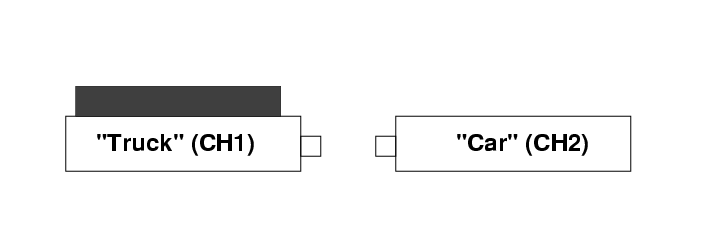
Name: ____________________________
A common (but confusing) statement of Newton's Third Law is For every action there is an equal and opposite reaction. In this activity we will measure forces with force sensors and try to understand the real meaning of Newton's Third Law.

First situation: I will hold the truck with my left hand and the car with my right hand. I'll slide them together gently, and press them together as they sit motionless on the table. This corresponds to a real car gently rolling up to a stationary truck and then trying -- futilely -- to push the truck forward. Which object exerts a bigger force on the other?
Second situation: I'll leave the truck sitting by itself on the table. Then I'll slowly slide the car so that its bumper presses against the bumper of the truck. Then I'll push harder on the car, so that it causes the truck to start to slide backwards on the table. I'll keep pushing so that the car pushes the truck backwards at an accelerating rate. This corresponds to a strong little car successfully pushing a big truck backwards. Now which object exerts a bigger force on the other?
Third situation: I'll make the truck move very fast and then ram it into the stationary car. The car will go flying backwards. Now which object exerts a bigger force on the other?
Discuss your answers with the others in your group and record your consensus answers in a table that looks like this:
Situation Magnitude of force Measurements
of car on truck is
< or = or >
force of truck on car
-----------------------------------------------------------------------------
Vehicles push each | |
other in stationary | |
position, no motion | |
| |
-----------------------------------------------------------------------------
Car pushes truck | |
backwards at an | |
accelerating rate | |
| |
-----------------------------------------------------------------------------
Truck slams into | |
stationary car | |
| |
-----------------------------------------------------------------------------